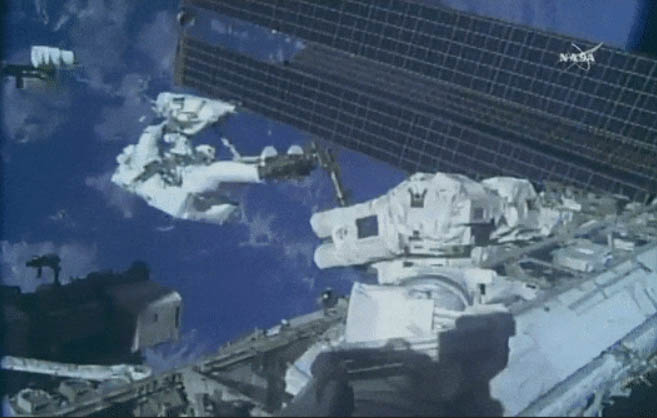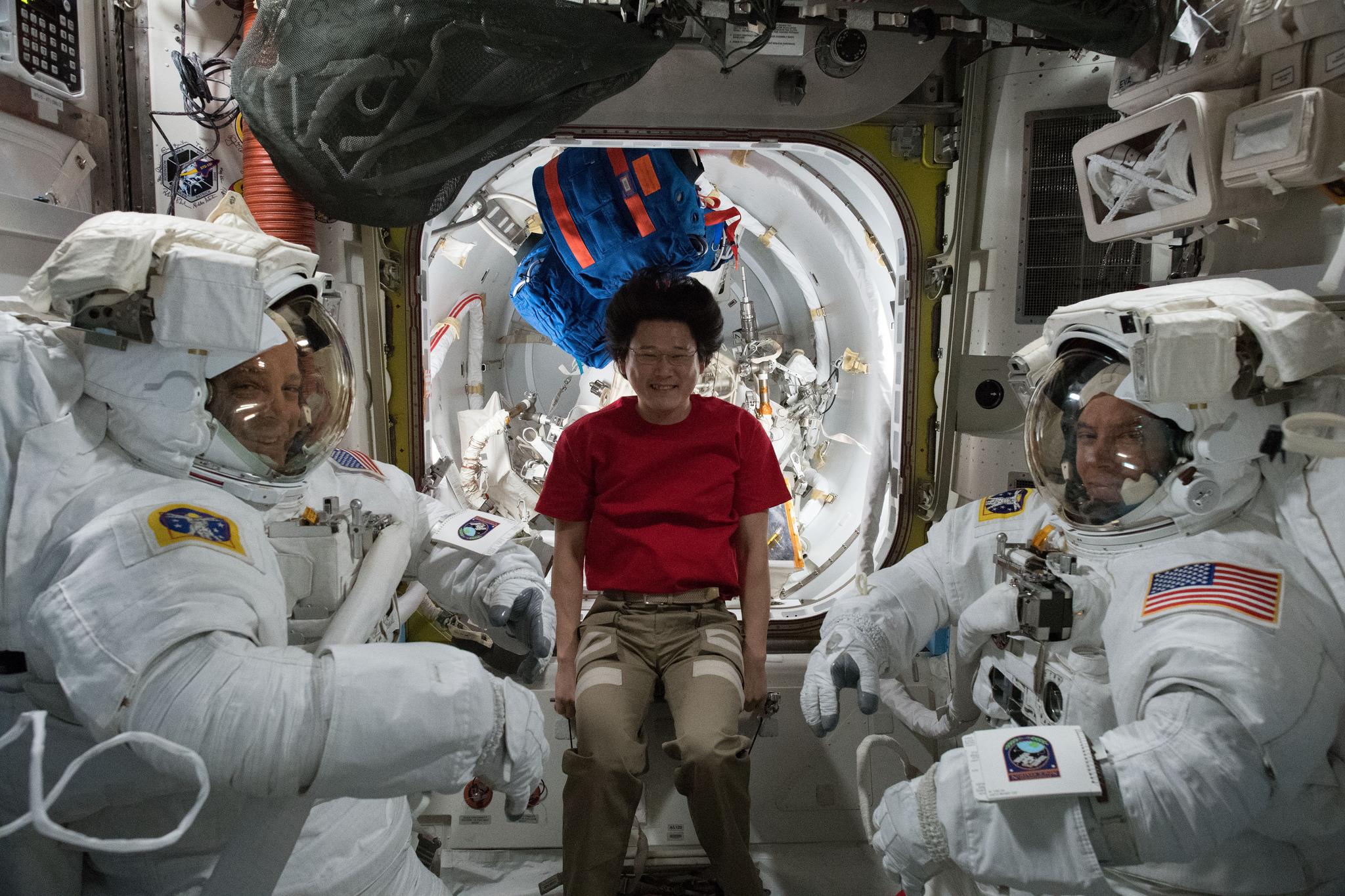Spacewalking Astronauts Replace Leaky Pump on Space Station
Two NASA astronauts took a 6.5-hour spacewalk outside the International Space Station today (May 16), breezing through all of their planned work and optional "get-ahead" tasks right on time.
Clad in their extravehicular mobility units (EMUs), aka spacesuits, Expedition 55 flight engineers Drew Feustel and Ricky Arnold emerged through the Quest airlock at 8:39 a.m. EDT (1239 GMT) before spending their day working in the vacuum of space to install some new hardware.
Their primary objective was to relocate a failed pump on the station's cooling system, which uses a liquid-ammonia cooling loop to keep the station's enormous solar panels and batteries from overheating. They also installed some new communications equipment to ready the station for commercial crew vehicles like Boeing's CST-100 Starliner and SpaceX's Crew Dragon, both of which could begin uncrewed test flights to the space station as early as August. [Space Station Photos: Expedition 55 Crew in Orbit]

As designated extravehicular crewmember 1 (EV1), Feustel wore the suit with red stripes, while Arnold wore a plain white suit. This helps ground controllers at NASA's Johnson Space Center in Houston tell the difference between the two spacewalkers as they watch live video transmissions from the station's external cameras.
The first order of business was to swap out the failed Pump Flow Control Subassembly (PFCS) unit, which NASA has nicknamed "Leaky." After it started leaking ammonia in 2013, the problematic pump was replaced with a spare and was stowed nearby on the P6 Truss segment. Today, the spacewalkers moved Leaky to an external stowage platform (ESP-1) to make room for a more reliable spare unit, dubbed "Frosty." If future spacewalkers ever need to replace the PFCS in the event of another leak, Frosty will be in a "strategically advantageous" position at the P6 Truss.
After Leaky and Frosty traded places, the spacewalkers installed a new high-definition camera assembly on the Destiny Laboratory and replaced a communications receiver on one of the space-to-ground antennas at the Z1 Truss segment. For their "get-ahead" tasks, the astronauts installed some new handles outside the station and stored a thermal cover near a particle detector experiment known as the Alpha Magnetic Spectrometer.
Upon returning to the Quest airlock to open the hatch, Feustel knocked on the door and said, "Anyone home? Trick or treat!" Japanese astronaut Norishige Kanai and NASA astronaut Scott Tingle were waiting to greet the spacewalkers at the door, but they didn't appear to have any candy around for these off-season trick-or-treaters.
Get the Space.com Newsletter
Breaking space news, the latest updates on rocket launches, skywatching events and more!
The spacewalk officially ended when Feustel and Arnold switched their spacesuits off of battery power at 2:10 p.m. EDT (1810 GMT). It lasted 6 hours and 31 minutes, just 1 minute longer than NASA had planned.

This was the 210th spacewalk in support of construction and maintenance of the International Space Station. It was Feustel's eighth spacewalk, and he has now accrued 54 hours and 59 minutes of spacewalking time. It was the fourth spacewalk of Arnold's career, bringing his accumulated spacewalking time to 25 hours and 15 minutes.
Feustel and Arnold have now completed two spacewalks together; their first excursion was on March 29. The duo will head out for a third consecutive spacewalk together on June 14, when they'll continue prep work for commercial crew vehicles.
Email Hanneke Weitering at hweitering@space.com or follow her @hannekescience. Follow us @Spacedotcom, Facebook and Google+. Original article on Space.com.
Join our Space Forums to keep talking space on the latest missions, night sky and more! And if you have a news tip, correction or comment, let us know at: community@space.com.

Hanneke Weitering is a multimedia journalist in the Pacific Northwest reporting on the future of aviation at FutureFlight.aero and Aviation International News and was previously the Editor for Spaceflight and Astronomy news here at Space.com. As an editor with over 10 years of experience in science journalism she has previously written for Scholastic Classroom Magazines, MedPage Today and The Joint Institute for Computational Sciences at Oak Ridge National Laboratory. After studying physics at the University of Tennessee in her hometown of Knoxville, she earned her graduate degree in Science, Health and Environmental Reporting (SHERP) from New York University. Hanneke joined the Space.com team in 2016 as a staff writer and producer, covering topics including spaceflight and astronomy. She currently lives in Seattle, home of the Space Needle, with her cat and two snakes. In her spare time, Hanneke enjoys exploring the Rocky Mountains, basking in nature and looking for dark skies to gaze at the cosmos.









